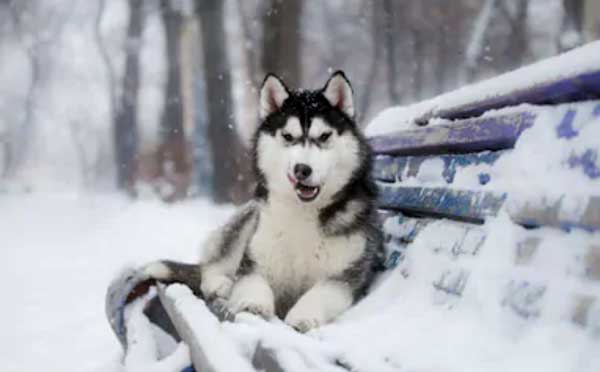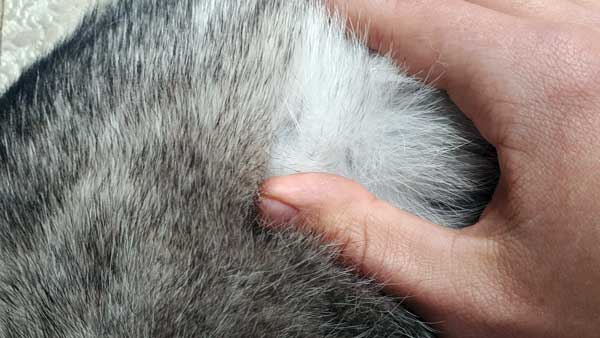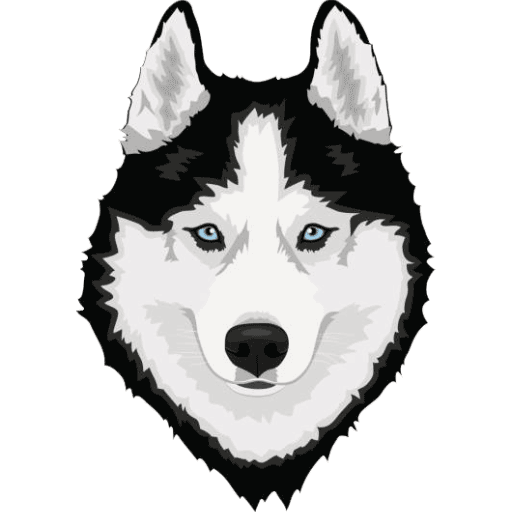One look at a photo of a Husky in the snow and it becomes pretty clear that Huskies are well-adapted to deal with the cold.
Understanding how Huskies can deal with cold temperatures will help you keep your Siberian Husky happy and healthy.
Huskies are capable of tolerating cold temperatures as low as -75°F (-59°C). How well Huskies can deal with the cold depends on their health, condition of their coat, shelter, and age.
In this guide, I will explain why the above information shouldn’t be relied on when making decisions over whether your Husky should stay outside or not in winter.

If you are deciding whether to keep your Husky as an indoor or outdoor dog, this short guide will tell you everything you need to know.
How Cold is Too Cold for a Husky?
A Siberian Husky is able to deal with cold temperature thanks to its double-coat as explained in this article.

The Husky’s double-coat gives them protection against the wind, cold, and rain, but only to an extent.
For example, compare a Husky trying to sleep outside without any shelter from rain and wind. Now compare that to another Husky living in the same area able to sleep in an insulated shelter.
It should be obvious that the Husky with good shelter will find it much easier to deal with the poor weather.
While Huskies have been reported to be able to withstand temperatures as low as -75°F (-59°C), don’t expect your Husky to handle such low temperatures.
A working Husky living in a pack may be able to survive extreme temperatures by huddling together, but a pet Husky in your backyard may not fare so well against the cold.
There is no way to know what the safe temperature limit is for your Husky. So let’s look at important signs to keep an eye on to know whether your Husky is adequately dealing with the temperature.
Signs That It Is Too Cold For Your Husky
The best way to know how cold is too cold for your Husky is to pay close attention to its behavior. Here are some signs to keep an eye on:
Shivering
If your Husky shows signs of shivering, it’s a serious sign the temperature is too low.
Even if you’ve read that Huskies can survive extremely low temperatures, pay attention to your Husky’s behavior for a better indication on what they can deal with.
A Husky will begin to shiver only after struggling for some time to stay warm. So this is not to be seen as an early warning sign – it is a sign that your Husky is struggling to stay warm.
Ice on Your Husky’s Fur
A clear sign that your Husky is not dealing well with the cold temperature is if you see ice on their fur.
Ice on a Husky’s fur is a sign that their body isn’t producing enough heat to deal with the cold.
If the Husky can’t produce enough body heat to melt ice on their fur, the ice will reduce the effectiveness of their coat’s insulation and make the situation worse.
If you notice snow quickly melt away on your Husky’s fur, it’s a good sign that your Husky’s body temperature is able to deal with the cold temperature. This can change over time, so keep an eye on any changes.
Anxiety
A Husky may become anxious or show signs of fear if they are struggling to deal with the weather.
If you notice any odd behavior such as your Husky trying to sleep in weird locations, excessive whining, or barking while staring at your eyes, take it as a serious warning sign.
If your Husky refuses to go outside, take it as a sign that your Husky knows it is too cold for them to deal with.
How to Keep Your Husky Safe in Low Temperatures
If your Husky is or will be an outdoor dog, it is crucial that you keep it safe during winter.
For some owners who don’t experience extreme cold during winter (I live in Australia in an area that never reaches sub-zero temperatures during winter), this could be as simple as having a simple dog house where your Husky can escape the rain or wind.
For other owners who deal with extremely low temperatures during winter, more drastic measures should be taken to ensure the safety of your Husky.
Here are some things to consider:
Providing Adequate Shelter For Your Husky
Imagine sleeping in a tent in the snow without a sleeping bag. While the tent keeps you separated from the snow, it isn’t going to do much to keep you warm.
Sleeping in a tent with a decent sleeping bag makes a significant difference in the temperature range you can deal with.
It’s the same with your Husky. While a Husky’s double-coat does an amazing job at insulating them from the cold, it has limits.
A shelter can make a huge difference in keeping your Husky protected from wind and rain. A well-sheltered Husky can endure far lower temperatures or bad weather.
You want the dog house to be big enough that your Husky can move around in, but small enough that the heat from your Husky keeps the surrounding air warm.
Insulating Your Husky’s Shelter
Insulating your Husky’s shelter dramatically increases your Husky’s ability to deal with cold weather.
While you may feel that stuffing the dog house with blankets is all that you need to do, the type of insulation you use to keep your Husky warm matters.
For example, to us, blankets are excellent at keeping us warm. But imagine a Husky covered in snow laying on some wool blankets. It won’t take long for the snow to melt and stop the blankets from properly insulating your Husky.
Damp blankets could have the opposite effect on your Husky and make the problem worse.
If you live in an area where you will experience sub-zero temperatures during winter, consider using a thick layer of straw or hay as insulation.
Straw or hay may not seem as effective as a blanket to us, but it will work wonders for your Husky.
If the straw becomes wet, it will lose its insulation properties. So keep an eye on the straw used and change it as needed to keep your Husky’s house nice and dry.
If your Husky won’t be exposed to snow, then blankets are perfectly fine. If it rains, make sure your Husky doesn’t go into its house dripping wet. Keeping the blankets dry is important for them to be effective insulators.
Door to Shelter
Depending on where you live and where you place your Husky’s shelter, you may not need a door. If the shelter’s opening is protected from direct wind and the shelter is small enough with proper insulation, your Husky may be perfectly fine.
But if you have any doubts, consider having a door to the shelter to prevent any wind or rain entering. Not only will this protect your Husky from the environment, but it will also help the air in the shelter warm up.
Having a door that can close makes a significant difference in keeping your Husky warm while in its house.
Husky Puppies and Cold Weather
Husky puppies aren’t as capable of tolerating cold weather as Husky adults.
A Husky puppy’s coat isn’t enough to withstand cold temperature. One look at a Husky puppy and it should be obvious that their coat doesn’t provide much protection.
The below photo shows my Husky, Sasha, when she was a puppy:

Not only is her small body not capable of generating enough heat to keep her warm in cold temperatures, but the thin and light coat doesn’t provide much protection.
Husky puppies are not capable of withstanding cold temperatures. Extra care and protection must be provided to Husky puppies during winter until their coats develop enough to provide adequate protection.
For many people, this means keeping your Husky puppies indoors at night to protect them from cold temperatures or extreme weather.

